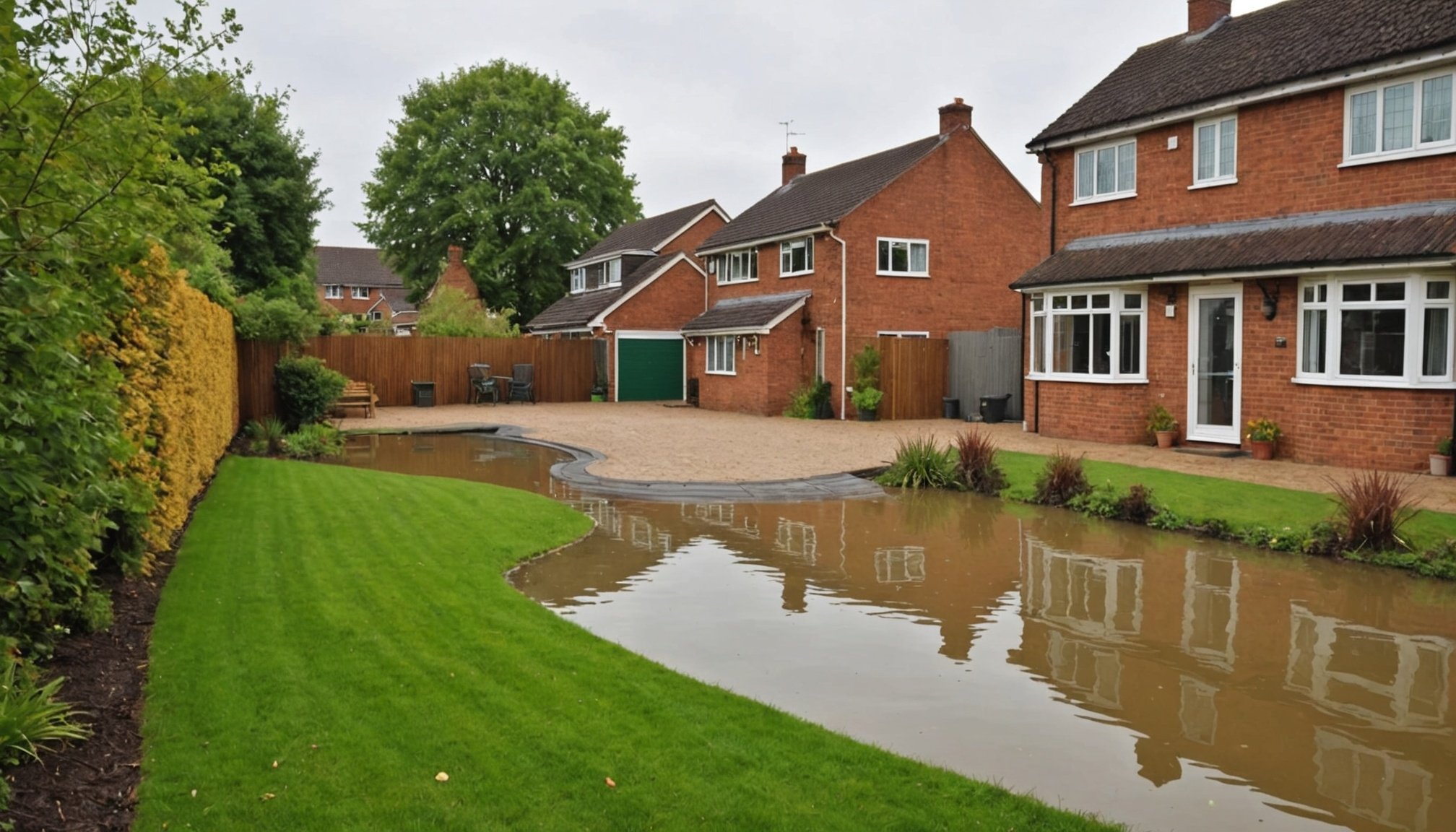Designing Your Landscape to Withstand Floods: An Ultimate Guide for UK Homeowners
As a homeowner in the UK, you are likely no stranger to the risks associated with flooding. With climate change exacerbating weather extremes, it is more crucial than ever to design your landscape with flood resilience in mind. Here’s a comprehensive guide to help you protect your home and garden from the impacts of flooding.
Understanding Flood Risk and Its Implications
Before diving into the design aspects, it’s essential to understand the flood risk associated with your property. The UK is prone to various types of flooding, including river flooding, coastal flooding, and surface water flooding. Here are some key points to consider:
Additional reading : Transform your urban oasis: creative design strategies for multifunctional outdoor gardens in the uk
- Flood Zones: Check with the Environment Agency to determine if your property is located in a high-risk flood zone. This information will help you tailor your landscape design accordingly[4].
- Climate Change: Climate change is leading to more frequent and intense weather events. This means that even areas not traditionally at risk may now face increased flooding threats.
- Insurance and Financial Implications: Understanding your flood risk can also help you navigate insurance options. Many homeowners in high-risk areas benefit from the Government’s Flood Re scheme, which makes affordable flood insurance available[4].
Assessing Your Property and Soil
To design a flood-resilient landscape, you need to start with a thorough assessment of your property and soil.
Soil Type and Drainage
The type of soil on your property plays a critical role in how water is absorbed and drained.
Also read : Innovative space-saving solutions for compact bathrooms in the uk
- Soil Testing: Perform a percolation test to determine how well your soil drains. Sandy or loamy soils are generally better than clay soils, which may require amendments to improve drainage[2].
- Drainage Systems: Implement efficient drainage systems, such as permeable surfaces and rain gardens, to manage excess water effectively.
Topography and Water Flow
Understanding the topography of your land and how water flows across it is vital.
- Water Flow Patterns: Identify areas where water tends to collect during heavy rainfall. This will help you design your landscape to direct water away from your home and garden[2].
- Elevation: If possible, consider raising certain areas of your garden or using raised beds to protect plants from floodwaters.
Designing Flood-Resilient Gardens
Creating a flood-resilient garden involves several key elements.
Rain Gardens
Rain gardens are an excellent way to manage stormwater runoff and reduce the risk of flooding.
- Planning and Design: Choose an area that collects water during heavy rainfall, ensuring it is at least 10 feet away from your home. The size of the rain garden should be 20-30% of the area draining into it[2].
- Plant Selection: Use native plants that can tolerate both wet and dry conditions. Examples include sedges, cardinal flowers, coneflowers, and ornamental grasses[2].
Permeable Surfaces
Permeable surfaces help reduce surface water runoff and prevent flooding.
- Materials: Use materials like gravel, permeable pavers, or gabion baskets filled with rocks. These allow water to flow through them, reducing the risk of flooding[2][3].
- Installation: Ensure proper installation, including a suitable foundation and drainage channels, to maintain the effectiveness of these surfaces.
Resilient Plants
Selecting plants that are resilient to flooding is crucial for maintaining a vibrant garden.
- Drought-Tolerant Species: Choose plants that require minimal watering, such as lavender, sedum, or ornamental grasses. These plants can thrive during dry spells and recover quickly from flooding[1].
- Native Plants: Native plants are generally more resilient and require less maintenance. They also support local biodiversity, which is beneficial for the ecosystem[1].
Using Smart Technology and Innovative Materials
Incorporating smart technology and innovative materials can enhance the flood resilience of your landscape.
Smart Irrigation Systems
Automated irrigation systems can adjust to weather conditions, ensuring optimal hydration for your plants while conserving water.
- Weather-Responsive Systems: Invest in smart watering systems that can detect rainfall and adjust watering schedules accordingly. This helps in conserving water and reducing the risk of overwatering[1].
Gabion Baskets
Gabion baskets are versatile and eco-friendly structures that can be used in various landscape designs.
- Environmental Benefits: Gabion baskets are made from recyclable materials and allow water to flow through them, reducing runoff and erosion. They also create micro-habitats for small plants and animals[3].
- Practical Applications: Use gabion baskets for retaining walls, erosion control, and garden features. They are durable, cost-effective, and offer a natural, rustic look[3].
Creating a Wellness-Focused and Wildlife-Friendly Garden
While designing for flood resilience, you can also create a garden that promotes well-being and supports local wildlife.
Wellness Gardens
Design areas dedicated to mindfulness activities, such as yoga or meditation, to enhance tranquility.
- Natural Materials: Use organic materials like wood and stone to create a harmonious environment. Incorporate water features or scented plants to enhance the sensory experience[1].
- Privacy and Comfort: Identify a quiet corner of your garden and ensure it is private and comfortable. This can include seating areas and decorative elements that promote relaxation.
Wildlife-Friendly Features
Support local biodiversity by creating habitats for wildlife.
- Pollinator Plants: Grow a variety of flowering plants that attract bees, butterflies, and other pollinators. This aids in the health of local ecosystems[1].
- Habitat Features: Incorporate birdhouses, insect hotels, or ponds to provide shelter and resources for various species. Research native plant species and suitable habitat features to integrate them thoughtfully into your garden design[1].
Maintenance and Upkeep
While designing a flood-resilient landscape is crucial, regular maintenance is equally important.
Regular Inspections
Check your garden regularly for any blockages or damage to drainage systems.
- Inlets and Outlets: Ensure that inlets and outlets of your rain garden or other water management systems are clear of debris[2].
- Plant Health: Monitor the health of your plants and trim overgrown plants to maintain the garden’s appearance and ensure proper water flow.
Seasonal Adjustments
Adjust your garden care according to the seasons.
- Winter Preparation: Prepare your garden for winter by ensuring that all drainage systems are clear and that plants are protected from extreme weather conditions.
- Spring Maintenance: In the spring, inspect your garden for any damage from winter weather and perform necessary repairs.
Practical Tips and Considerations
Here are some practical tips and considerations to keep in mind when designing your flood-resilient landscape:
Budgeting
- Cost-Effective Solutions: Gabion baskets and permeable surfaces can be more cost-effective than traditional masonry or concrete structures, especially when using locally sourced materials[3].
Insurance and Financial Planning
- Flood Insurance: Ensure you have adequate flood insurance coverage. If your property is in a high-risk area, consider the Government’s Flood Re scheme[4].
Community Resources
- Local Advice: Consult with local landscape architects or the Environment Agency for specific advice tailored to your region’s flood risks and regulations.
Designing a landscape that withstands floods is not just about protecting your home and garden; it’s also about creating a sustainable, functional, and serene environment. By incorporating smart technology, innovative materials, and resilient design principles, you can ensure your property remains safe and beautiful even in the face of extreme weather events.
Here is a detailed bullet point list summarizing the key steps to designing a flood-resilient landscape:
- Assess Your Property: Determine your flood risk and assess your soil type and drainage.
- Design Rain Gardens: Create rain gardens with native plants and permeable surfaces.
- Use Resilient Plants: Select drought-tolerant and native plants that can withstand flooding.
- Incorporate Smart Technology: Use automated irrigation systems and garden monitoring devices.
- Utilize Gabion Baskets: Implement gabion baskets for retaining walls, erosion control, and garden features.
- Create Wellness and Wildlife-Friendly Spaces: Design areas for mindfulness and incorporate features that support local wildlife.
- Regular Maintenance: Inspect and maintain your garden regularly to ensure the effectiveness of your flood resilience measures.
By following these steps and considering the practical tips and considerations outlined above, you can build a flood-resilient landscape that not only protects your home but also enhances its beauty and functionality.
Table: Comparing Different Flood Resilience Measures
| Measure | Description | Benefits | Cost |
|---|---|---|---|
| Rain Gardens | Shallow basins that collect and filter rainwater | Reduces surface water runoff, filters pollutants, supports local wildlife | Moderate to High |
| Gabion Baskets | Wire mesh containers filled with rocks or other materials | Permeable, durable, cost-effective, supports biodiversity | Moderate |
| Permeable Surfaces | Surfaces that allow water to flow through them | Reduces surface water runoff, prevents flooding | Moderate to High |
| Smart Irrigation Systems | Automated systems that adjust to weather conditions | Conserves water, reduces overwatering risk | High |
| Resilient Plants | Plants that can withstand flooding and drought | Low maintenance, supports local ecosystems | Low to Moderate |
| Raised Beds | Elevated garden beds | Protects plants from floodwaters, improves drainage | Moderate |
Quotes from Experts
- “Rain gardens are an excellent way to manage stormwater runoff and reduce the risk of flooding. By using native plants and strategic landscaping, these gardens effectively reduce water pollution, prevent flooding, and create habitats for local wildlife.” – Luxury Home Design[2]
- “Gabion baskets offer immense flexibility in design and are incredibly durable. They allow water to flow through them, reducing runoff and erosion, and can be used to create various garden elements.” – Terrock Gabion[3]
- “Understanding your flood risk is crucial for designing a flood-resilient landscape. Check with the Environment Agency to determine if your property is located in a high-risk flood zone.” – Telegraph Money[4]
By integrating these elements and following the practical advice outlined in this guide, you can create a landscape that is not only beautiful but also resilient to the challenges posed by flooding.



